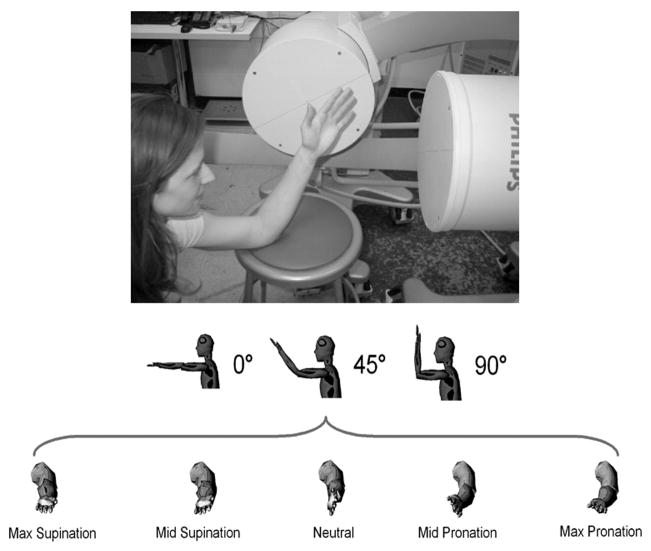Abstract
Previous in vivo and in vitro studies of forearm supination/pronation suggest that distal radioulnar joint kinematics may be affected by elbow flexion. The primary hypotheses tested by this study were that in vivo: 1) ulnar variance changes with elbow flexion and forearm rotation and 2) the arc of forearm rotation changes in relationship to elbow flexion.
Materials and Methods
Changes in radioulnar kinematics during forearm supination/pronation and elbow flexion (0–90°) were studied in five uninjured subjects using computed tomography, dual-orthogonal fluoroscopy, and three-dimensional modeling. Analysis of variance and post-hoc testing was performed.
Results
Proximal translation of the radius was greatest with the elbow flexed to 90° with the arm in mid-pronation. With the arm in mid-pronation, the translation of the radius was significantly greater at 0° versus 45° of elbow flexion (0.82 ± 0.59 mm v. 0.65 ± 0.80 mm, F: 4.49, Post Hoc: 0.055; p = 0.05), and significantly smaller at 45° versus 90° of elbow flexion (0.65 ± 0.80 mm v. 0.97 ± 0.35 mm, F: 4.49, Post Hoc: 0.048; p = 0.05). Proximal translation of the radius in mid-pronation was significantly greater than when the forearm was in a supinated position when the elbow was at 0° or 90° flexion (F: 14.90, post-hoc: < 0.01; p < 0.01, F: 19.11, post-hoc: < 0.01, p < 0.01). The arc of forearm rotation was significantly decreased at 0° compared to 90° of elbow flexion (129.3 ± 22.2° v 152.8 ± 14.4°, F: 3.29, post-hoc: 0.79; p = 0.09). The center of rotation shifted volarly and ulnarly with increasing elbow extension.
Discussion
Elbow position affects the kinematics of the distal radioulnar joint. The kinematics of the distal radioulnar joint are primarily affected by forearm rotation and secondarily affected by elbow flexion. These findings have clinical relevance to our understanding of ulnar impaction, and how elbow position affects the proximal-distal translation of the radius. These findings have implications upon the treatment of ulna impaction, radiographic evaluation of the distal ulna, and future biomechanical studies.
Keywords: elbow, distal radioulnar, kinematics, biomechanics, forearm
Introduction
Radiographic and cadaveric studies have been used to investigate in vivo and in vitro ulnar variance changes with forearm supination and pronation, in healthy and pathologic subjects (1–4). Ulnar variance is standardized in these studies where the shoulder is placed in 90° of abduction and the elbow flexed to 90° the forearm in neutral rotation. However, it is unclear whether the position of elbow flexion intrinsically affects ulna variance.
Tay et al. used finite helical axis analysis to describe the in vivo kinematics of the forearm and found proximal-distal translation of the radius relative to the ulna with rotation of the forearm (5), suggesting that elbow position may affect distal forearm kinematics. However, because imaging techniques such as computed tomography and magnetic resonance imaging have geometric limitations, and plain radiography is not as precise as these other techniques; the effect of elbow flexion on the distal radioulnar joint has not been well studied.
Recently, a combined dual fluoroscopic and MR/CT imaging technique has been developed that allows measurement of joint motion without constraints of the target joint (6, 7). This technique has been successfully applied to the lower extremity (8–10). In this study, we utilized this imaging technique to explore the relationship of distal radioulnar joint kinematics with elbow and forearm positions. The primary hypotheses tested are: 1) proximal-distal translation of the radius relative to the ulna changes in relationship to elbow flexion and forearm rotation and 2) the arc of forearm rotation changes in relationship to elbow flexion.
Materials and Methods
This study was approved by the Institutional Review Board and informed consent was obtained for each subject. Five right dominant upper extremities without a history of previous injury from right-hand dominant male volunteers (age 24 to31) were imaged while in neutral forearm rotation and elbow extension by computed tomography (GE Light Speed Pro 16-Slice scanner). Parallel axial CT images separated at 0.625mm with a resolution of 512 × 512 pixels were obtained. Each CT image was processed using a Canny filter programmed in a commercially available mathematics software package (Matlab, Mathworks, Canton, MA). The Canny filter calculates gradients in pixel intensity to detect edges between objects. The calculated edges were used to help trace the outlines of the radius and ulna within the axial plane image using solid-modeling software (Rhinoceros®, Robert McNeel & Associates, Seattle, WA). The contours were then placed in the appropriate plane in a 3D space, and the surface was meshed using the solid-modeling software.
After CT image-based computer 3D models were constructed, each subject was imaged using two orthogonally placed fluoroscopes (BV Pulsera, Philips, Bothell, WA) at elbow flexion angles of 0°, 45°, and 90° as the subject rotated his/her forearm from maximum supination, 50% supination, neutral, 50% pronation, and maximum pronation (Fig 1a). The wrist was placed in zero degrees of extension and zero degrees of radioulnar deviation and the metacarpalphalangeal, proximal interphalangeal, and distal interphalangeal joints were held in extension. These positions were confirmed with goniometer. Each subject practiced the testing positions five times before actual testing. The degree of prononation/supination was estimated from the pre-conditioning trials with the understanding that the true amount of rotation would be defined with the modeling techniques. During imaging, the plane of the C-arm was co-planar to the floor and the subject was seated with the elbow stabilized on a radiolucent table (Figure 1). The subject held each position which was confirmed with a goniometer and then the image was acquired. The entire testing procedure took about 10 minutes.
Figure 1.
Dual fluoroscopic imaging system. Subject with elbow at 45° flexion and forearm in neutral rotation. Images were captured at elbow flexion angles of 0°, 45°, and 90° with the forearm at maximum supination, mid-supination, neutral, mid-pronation, and maximum pronation.
The orthogonal images were then imported into a solid modeling software (Rhinoceros®, Robert McNeel & Associates, Seattle, WA Rhinoceros, Seattle, Wash) and used to determine the in vivo forearm positions at each of the targeted flexion angles. The orthogonal images were placed in the software to reproduce the positions of the two intensifiers of the fluoroscope during image acquisition. The forearm model was imported into the virtual space and was viewed simultaneously from two orthogonal directions corresponding to the positions of the x-ray source of the fluoroscope during image acquisition. The 3D forearm model was then manipulated in six degrees of freedom inside the 3D C-arm until its projections viewed from two orthogonal directions matched the outlines of the fluoroscopic images obtained, thus reproducing the in vivo forearm position using the 3D anatomical models. The method has been previously validated on a knee model to an accuracy of 0.1 mm position and 0.1 degrees rotation (6,7).
To describe the six degrees of freedom (6DOF) kinematics of the distal radioulnar joint (DRUJ), anatomically based ulnar and radial Cartesian coordinate systems similar to that reported previously in the literature were constructed for each subject (Figure 2). The position of the forearm in neutral position during CT scanning was used as a reference. For the ulnar coordinate system, the longitudinal axis (z-axis) was defined as the line passing through the longitudinal axis of the ulna. The y-axis was defined as the line passing from the center of the ulnar head to through the center of the ulnar styloid base. The x-axis was an axis perpendicular to those two axes pointing dorsally. The radial longitudinal axis (z-axis) was the long-axis of the radius. The y-axis was defined as the line passing through the anatomic center of the distal radius to the tip of the radial styloid. The x-axis was an axis perpendicular to those 2 axes pointing dorsally. In this manner, a coordinate system for each wrist could be established in a consistent way. The axes used to describe the radius are similar to those used clinically to describe the forearm.
Figure 2.
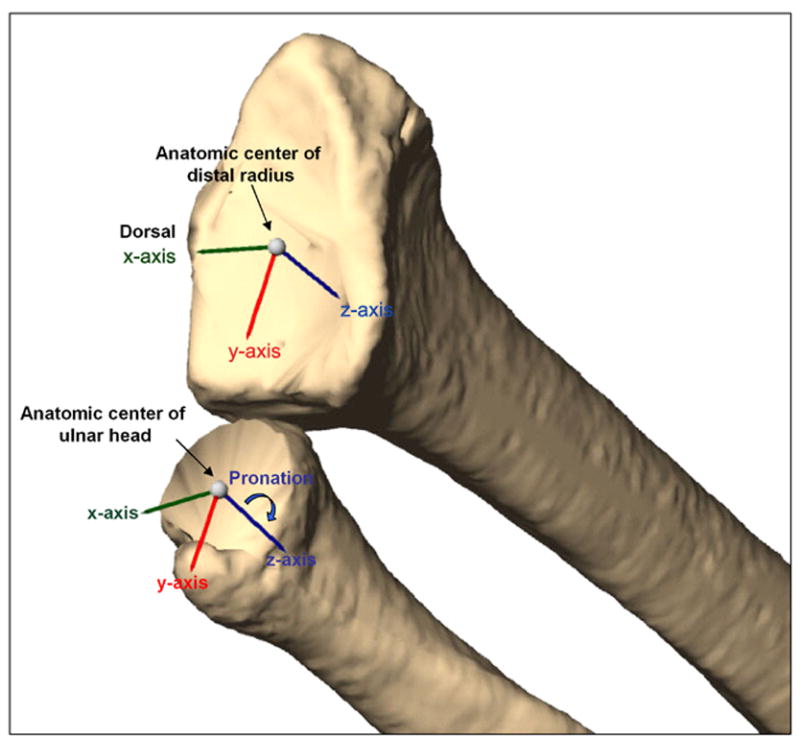
The coordinate systems used to describe radioulnar kinematics. The ulnar y-axis, a line the center of the ulnar head to the center of the ulna styloid, was used to delineate supination from pronation.
The 6DOF kinematics of the wrist was described by the relative position and orientation of the distal radius with respect to the ulnar head using a script written by our laboratory for Rhinoceros solid modeling software. The three-dimensional positions were determined by the position of the origin of the distal radius coordinate system in the ulnar head coordinate system. The orientation was represented by the relative orientation of the distal radius coordinate system with respect to the ulnar styloid coordinate system using 3 Euler angles (in x-y-z sequence) (Figure 3). In this study, 6DOF was expressed using the radial displacements along the x,y, and z-axes of the ulna for anterior/posterior, ulnar/radial, and proximal/distal displacements and rotation about the z-axis for pronation/supination. Proximal translation of the radius relative to the ulna was defined as negative, whereas distal translation was positive.
Figure 3.
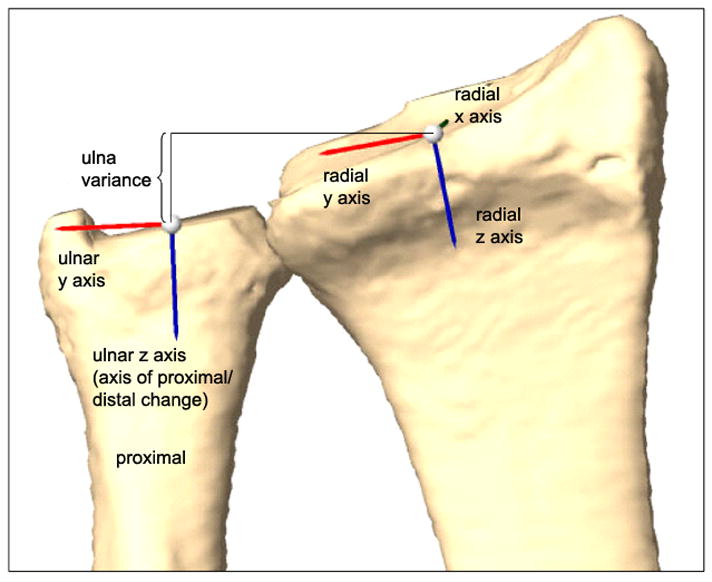
Change in ulna variance was measured from the neutral position for each angle of elbow flexion. Ulna variance was measured as the distance along the ulnar z-axis between the center of the radial coordinate system and the center of the ulnar coordinate system. Proximal translation of the radial coordinate system relative to the ulna coordinate was defined as negative, whereas distal translation was positive.
In order to characterize the overall effect of flexion and rotation at a specified elbow flexion angle, we examined the difference observed in proximal-distal translation between full supination and full pronation (terminal difference) versus the difference observed between the peak proximal and peak distal translation (peak difference).
To compare the actual path of rotation of the radius to the expected path of a perfect circle, we defined a circular path about the center of the ulnar coordinate system using the center of the radial coordinate systems and the “best fit circle” function within Rhinoceros (Figure 4). Lines extending from the center of the ulnar coordinate system were extended to the centers of the radial coordinate systems such that they intersected with the path of the best fit circle. The difference in distance between the actual and expected path of rotation were then measured along this line.
Figure 4.
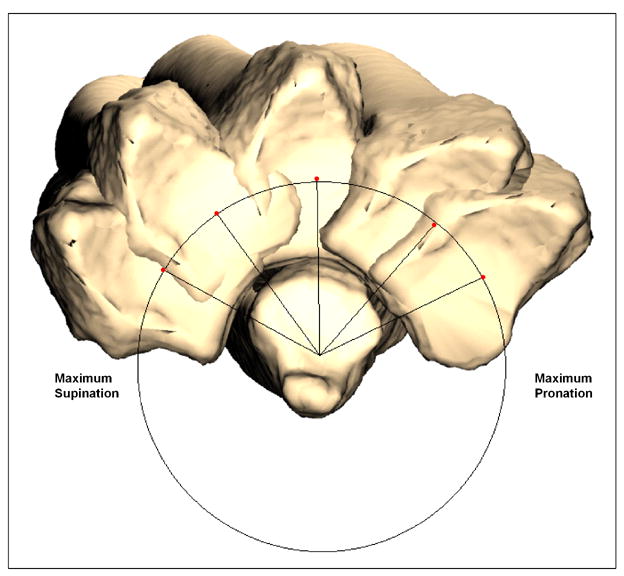
Center of rotation was determined by finding the best fit circle of the center points of the radial coordinate system. Deviations from this circular path were random and minor.
Because of the small sample size of the cohort, significance was pre-defined using an alpha of 0.10. Analysis of Variance (ANOVA) was used to compare the motion of the forearm among the different elbow flexion and rotation angles with Statistica 6.0 (StatSoft, Tulsa OK). Post-hoc testing using a Neuman Keul’s test was performed to evaluate differences between groups.
Results
Proximal/Distal Translation
Traditional ulna variance is measured at 90 degrees of elbow flexion and neutral rotation. In our subjects, ulna variance based on the model would be −0.24 ± 0.57 mm.
The proximal and distal translation of the radius relative to the ulna varied with elbow flexion. With the arm in mid-pronation, the translation of the radius was significantly greater at 0° versus 45° of elbow flexion (0.82 ± 0.59 mm v. 0.65 ± 0.80 mm, F: 4.49, Post Hoc: 0.055; p = 0.05), and significantly smaller at 45° versus 90° of elbow flexion (0.65 ± 0.80 mm v. 0.97 ± 0.61 mm, F: 4.49, Post Hoc: 0.048; p = 0.05) (Figure 5).
Figure 5.
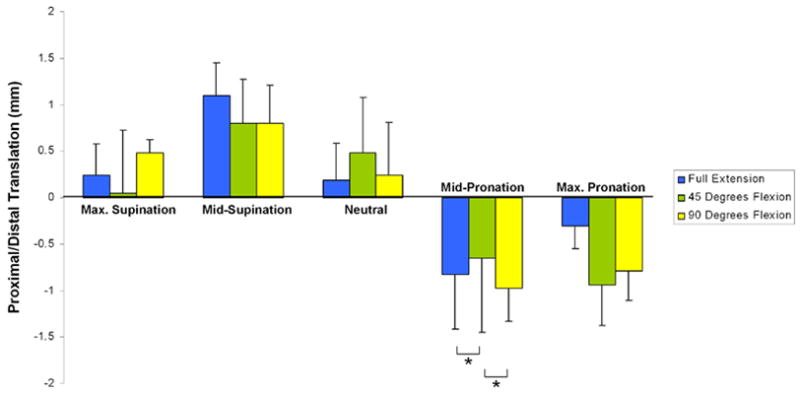
Proximal-distal translation of the radius relative to the ulna. Proximal translation of the radius relative to the ulna was defined as negative, whereas distal translation was positive.
When the elbow was at 0° or 90° flexion, the proximal and distal translation of the radius relative to the ulna was not maximal at extremes of pronation and supination. Rather, peak displacement was observed at mid-supination and mid-pronation. With the elbow in full extension, translation of the radius was significantly more in mid-supination than full supination (−1.10 ± 0.35 mm v. −0.24 ± 0.34 mm, F: 14.90, Post Hoc: 0.005; p < 0.01). With the elbow in full extension, translation of the radius was also significantly greater than when in mid-pronation than full pronation (0.82 ± 0.59 mm v. 0.3 ± 0.24 mm, F: 14.90, Post Hoc: 0.06; p < 0.01). Translation of the radius in mid-pronation was significantly greater when the forearm was in either mid-supination or terminal supination with the elbow at 0° or 90° flexion (F: 14.90, post-hoc: < 0.01; p < 0.01, F: 19.11, post-hoc: < 0.01, p < 0.01). Similarly, translation of the radius in mid-supination was significantly less than any other position of forearm rotation with the elbow at 0° or 90° flexion (F: 14.90, post-hoc: < 0.01; p < 0.01, F: 19.11, post-hoc: < 0.01, p <0.01).
In general, at each flexion angle, the peak difference was greater than the terminal difference. At 0° of elbow flexion, the terminal difference was significantly smaller than peak differences at all elbow flexion angles (F: 5.49, post-hoc: <0.05 for all flexion angles; p = 0.002). At 90° flexion, the peak difference was significantly greater than the terminal differences at all elbow flexion angles (F: 5.49, post-hoc: <0.05 for all flexion angles; p = 0.002).
Arc of Pronation/Supination
From maximal supination to maximal pronation, the DRUJ demonstrated an average of 141.8° ± 18.4° of total rotation for all angles of elbow flexion. Total arc of rotation increased with progressive elbow flexion. As elbow flexion increases, end-range pronation increases (F: 3.67, post-hoc 0° v 45°: 0.10, post-hoc 0° v 90°: 0.049; p = 0.07). The arc of rotation was significantly smaller at 0° compared to 90° of elbow flexion (129.3 ± 22.2° v. 152.8 ± 14.4°, F: 3.29, post-hoc: 0.79; p=0.09), (Table 1).
Table 1.
Total arc of rotation, maximum pronation, and maximum supination compared across elbow flexion angle. There was a significant difference between the range of rotation at 0° elbow flexion and 90°.
| Elbow Flexion | 0° | 45° | 90° |
|---|---|---|---|
| Total Arc of Rotation | 129.3 ± 22.2° | 143.4 ± 11.7° | 152.8 ± 14.4° |
| Maximum Pronation | 41.1 ± 15.5° | 57.7° ± 8.3° | 57.3 ± 5.9° |
| Maximum Supination | 88.2 ± 12.3° | 85.7 ± 8.0° | 95.5 ± 18.2° |
The radius rotated about the ulna in a circular path with a center of rotation located in the ulnar head with only minor deviations in the radius of rotation. At ninety-degrees of elbow flexion, the center of rotation was nearly coincident with the anatomic center of the ulnar head. The center of rotation of the radius shifted volarly and ulnarly with increasing elbow extension (Table 2, Figure 6). The location of the center of rotation was significantly different when the elbow was flexed to 90° as compared to the elbow in full extension (F: 3.31, post-hoc: 0.09; p = 0.08). The diameter of the circular path traversed by the radius relative to the ulna also changed with elbow flexion. The diameter was significantly different between 0° v. 45° (57.9 ± 8.3 mm v. 54.3 ± 4.4 mm, F: 3.13, post-hoc 0° v. 45°: 0.07; p = 0.10) (Table 2).
Table 2.
Ulnar and volar changes of the COR of the radius about the ulna. There was a significant difference in the ulnar displacement of the COR between 45° and 90° of elbow flexion.
| Elbow Flexion | Ulnar Displacement | Volar Displacement | Arc of Rotation Diameter |
|---|---|---|---|
| 0° | 3.1 ± 2.3mm | 1.7 ± 1.2mm | 57.9 ± 8.3 mm |
| 45° | 1.5 ± 1.4mm | 0.5 ± 0.8mm | 54.3 ± 4.4 mm |
| 90° | 0.5 ± 1.5mm | 0.1 ± 0.6mm | 55.0 ± 5.5 mm |
Figure 6.

Center of rotation (COR) of the radius about the ulna shifted with elbow flexion. There was a significant ulnar shift in the COR from 45° to 90° of flexion.
Discussion
This study examined the kinematics of the forearm using a combined dual fluoroscopy imaging system and CT imaging technique. To our knowledge, this is the first application of this type of technology to understanding the kinematics of the forearm. Strengths of this non-invasive imaging system are that this technique allows examination of a distal joint while a proximal joint is unconstrained and examination of forearm motion in the entire functional range of motion (6–10).
The first hypothesis, that ulnar variance changes with elbow flexion, was supported by our findings. Our data suggests that when the elbow is at 45° flexion, the radius translates proximally less than when the elbow is at full extension or 90° flexion. The maximum amount of distal or proximal translation of the radius relative to the ulna did not occur at terminal pronation or supination, but at mid-arc. One possible reason why maximal translation occurs during mid arc is that as the forearm approaches terminal rotation, the corresponding distal radioulnar ligament becomes taut and restricts longitudinal translation. The proximal structures such as the biceps and brachialis may also limit translation as the forearm approaches terminal supination with elbow extension.
Previous studies have suggested that elbow flexion and forearm rotation influence ulna variance. For example, Schuurman et al. examined ulna variance with the forearm in neutral rotation with the elbow at 90° of flexion compared to the forearm in full supination with the elbow at full extension and found differences of −0.18 ± 1.56 mm v. −0.86 ± 1.47 mm (1). Yeh et al. studied ulnar variance at maximum pronation, neutral rotation, and maximum supination using anteroposterior radiographs and found a total proximal-distal translation of 0.6 mm with confidence intervals of 0.4 mm to 0.8 mm, but also did not control for elbow flexion other than in neutral rotation (2). Using static CT scans, Tay et al. found proximal-distal translation of 1.67mm when moving from full pronation to full supination (5). We found a similar magnitude of mean maximum change between maximum pronation and maximum supination.
When comparing examining previous data, it is not clear to what degree elbow flexion or forearm rotation contributes to translation of the radius relative to the ulna. In general, we found that forearm rotation has a greater relative contribution to proximal-distal translation than elbow flexion. Rotation leads to changes of up to 2 mm, while elbow flexion leads to changes of up to 0.5 mm. Ultimately, our data suggests that ulna impaction on the carpus is most likely to occur when the forearm is in mid-pronation and the elbow is at 90 degrees of flexion or full extension.
The second hypothesis, that arc of rotation changes with elbow flexion was supported statistically. The total arc of rotation increases with increasing elbow flexion. We observed that as elbow flexion increased, the center of rotation of the radius approached the anatomic center of the ulna head; in addition, the diameter of that arc of rotation decreased significantly with elbow flexion. This suggests that the precession of the radius about the ulna changes with elbow flexion. Using a custom jig, Shaaban et al. found that total arc of rotation increased significantly from 0° to 45°, remained constant from 45° to 90°, and then decreased at full flexion (11). This was, in general, consistent with our results. The decrease of range of motion in extension may be a result of the biceps and other soft tissue restraints around the proximal radioulnar joint becoming tight at this position.
These findings are relevant in radiographic evaluations of the distal radioulnar joint and ulna variance and understanding injuries of the forearm. Studies have examined various methods of quantifying distal radioulnar joint dorso-volar translation and ulna variance (12, 13). In evaluating ulna variance, there is emphasis on elbow flexion and neutral forearm rotation, and the effect of proximal and distal joint positioning upon radiographic evaluation has been recognized by previous authors (1, 14, 15); however, this has not been systematically studied previously. Our results suggest that maximal distal radioulnar translation occurs when the elbow is flexed or fully extended and in mid-pronation.
Similar to Baeyens et al., we did not observe any volar/dorsal translation at the distal radioulnar joint at either maximum supination or pronation (16). Tay et al. demonstrated volar/dorsal translation of the radius relative to the ulna in vivo during resisted supination and pronation while gripping an external handle (5). Schiund et al. have also demonstrated a mean change of ulnar variance of 0.5mm during maximal grasp of a dynamometer (15). We did not alter finger or wrist flexion-extension throughout the experiment, suggesting that during elbow flexion, muscle forces across the distal radioulnar joint are such that the ulna remains centered in the sigmoid notch in vivo if the wrist and hand are not closed or experiencing an external load.
Limitations
Limitations of this study were the small number of subjects available for study. Ideally there would be a larger number of subjects and female subjects included however, practical considerations limited the number of participants and female subject enrollement. The small cohort also did not have any outliers with an ulna variance greater or less than two millimeters. The inclusion of these subjects may give insight into how deviations affect our measurements of translation or forearm kinematics. A second limitation was that it was not possible to perform fluoroscopy that encompassed the entire elbow and wrist joint at the same time because of the receiver size on the fluoroscopes. This would allow simultaneous analysis of the proximal and distal radioulnar joints. In addition, the position of the elbow could be more accurately described rather than using a goniometer for positioning. Finally, an ideal study would also include more positions of elbow flexion and points along the rotational arc and under dynamic forearm motions.
In conclusion, application of three dimensional solid modeling techniques in conjunction with dual orthogonal fluoroscopy demonstrates that the translation of the radius relative to the ulna, the arc of forearm rotation, and the size of the arc of forearm rotation changes with elbow flexion. These findings have implications in the treatment of ulna impaction, radiographic evaluation, and understanding of forearm kinematics. Future studies examining integrating soft tissue structures and dynamic forearm loading may be helpful in understanding the contribution of the distal radioulnar ligaments, triangular fibrocartilage, and interosseous membrane to these observations could help further elucidate our understanding of the in vivo kinematics of the distal radioulnar joint.
Acknowledgments
This research was funded by a Basic Science Grant from the American Foundation for Surgery of the Hand. We gratefully acknowledge the financial support of the Department of Orthopaedic Surgery at Massachusetts General Hospital. We thank Jeffrey Bingham, Shaobai Wang, and Michal Kozanek for their technical assistance.
Footnotes
Study performed at: Bioengineering Laboratory, Department of Orthopaedics, Massachusetts General Hospital/Harvard Medical School, Boston, MA
Publisher's Disclaimer: This is a PDF file of an unedited manuscript that has been accepted for publication. As a service to our customers we are providing this early version of the manuscript. The manuscript will undergo copyediting, typesetting, and review of the resulting proof before it is published in its final citable form. Please note that during the production process errors may be discovered which could affect the content, and all legal disclaimers that apply to the journal pertain.
References
- 1.Schuurman AH, Maas M, Dijkstra PF, Kauer JM. Assessment of ulnar variance: a radiological investigation in a Dutch population. Skeletal Radiol. 2001;30:633–8. doi: 10.1007/s002560100414. [DOI] [PubMed] [Google Scholar]
- 2.Yeh GL, Beredjiklian PK, Katz MA, Steinberg DR, Bozentka DJ. Effects of forearm rotation on the clinical evaluation of ulnar variance. J Hand Surg. 2001;26A:1042–1046. doi: 10.1053/jhsu.2001.26657. [DOI] [PubMed] [Google Scholar]
- 3.Epner RA, Bowers WH, Guilford WB. Ulnar variance—the effect of wrist positioning and roentgen filming technique. J Hand Surg. 1982;7:298 –305. doi: 10.1016/s0363-5023(82)80183-4. [DOI] [PubMed] [Google Scholar]
- 4.Palmer AK, Werner FW. Biomechanics of the distal radioulnar joint. Clin Orthop. 1984;187:26 –35. [PubMed] [Google Scholar]
- 5.Tay SC, Berger RA, Tomita K, Tan ET, Amrami KK, An KN. In vivo three-dimensional displacement of the distal radioulnar joint during resisted forearm rotation. J Hand Surg. 2007;32A:450–8. doi: 10.1016/j.jhsa.2007.01.007. [DOI] [PubMed] [Google Scholar]
- 6.Li G, Wuerz TH, DeFrate LE. Feasibility of using orthogonal fluoroscopic images to measure in vivo joint kinematics. J Biomech Eng. 2004;126:314–8. doi: 10.1115/1.1691448. [DOI] [PubMed] [Google Scholar]
- 7.Li G, Van de Velde SK, Bingham JT. Validation of a non-invasive fluoroscopic imaging technique for the measurement of dynamic knee joint motion. J Biomech. 2008;41:1616–22. doi: 10.1016/j.jbiomech.2008.01.034. [DOI] [PubMed] [Google Scholar]
- 8.Li G, DeFrate LE, Sun H, Gill TJ. In vivo elongation of the an terior cruciate ligament and posterior cruciate ligament during knee flexion. Am J Sports Med. 2004;32:1415–20. doi: 10.1177/0363546503262175. [DOI] [PubMed] [Google Scholar]
- 9.Li G, Papannagari R, Li M, Bingham J, Nha KW, Allred D, Gill T. Effect of posterior cruciate ligament deficiency on in vivo translation and rotation of the knee during weightbearing flexion. Am J Sports Med. 2008;36:474–9. doi: 10.1177/0363546507310075. [DOI] [PubMed] [Google Scholar]
- 10.Jordan SS, DeFrate LE, Nha KW, Papannagari R, Gill TJ, Li G. The in vivo kinematics of the anteromedial and posterolateral bundles of the anterior cruciate ligament during weightbearing knee flexion. Am J Sports Med. 2007;35:547–54. doi: 10.1177/0363546506295941. [DOI] [PubMed] [Google Scholar]
- 11.Shaaban H, Pereira C, Williams R, Lees VC. The effect of elbow position on the range of supination and pronation of the forearm. J Hand Surg Eur Vol. 2008;33:3–8. doi: 10.1177/1753193407087862. [DOI] [PubMed] [Google Scholar]
- 12.Park MJ, Kim JP. Reliability and normal values of various computed tomography methods for quantifying distal radioulnar joint translation. J Bone Joint Surg. 2008;90:145–53. doi: 10.2106/JBJS.F.01603. [DOI] [PubMed] [Google Scholar]
- 13.Pan CC, Lin YM, Lee TS, Chou CH. Displacement of the distal radioulnar joint of clinically symptom-free patients. Clin Orthop Relat Res. 2003;415:148–56. doi: 10.1097/01.blo.0000093906.12372.63. [DOI] [PubMed] [Google Scholar]
- 14.Tomaino MM. The importance of the pronated grip x-ray view in evaluating ulnar variance. J Hand Surg. 2000;25A:352–7. doi: 10.1053/jhsu.2000.jhsu25a0352. [DOI] [PubMed] [Google Scholar]
- 15.Schuind FA, Linscheid RL, An KN, Chao EYS. Changes in wrist and forearm configuration with grasp and isometric contraction of the elbow flexors. J Hand Surg. 1992;17A:698–703. doi: 10.1016/0363-5023(92)90320-o. [DOI] [PubMed] [Google Scholar]
- 16.Baeyens JP, Van Glabbeek F, Goossens M, Gielen J, Van Roy P, Clarys JP. In vivo 3D arthrokinematics of the proximal and distal radioulnar joints during active pronation and supination. Clin Biomech (Bristol, Avon) 2006;21 (Suppl 1):S9–12. doi: 10.1016/j.clinbiomech.2005.09.008. [DOI] [PubMed] [Google Scholar]



